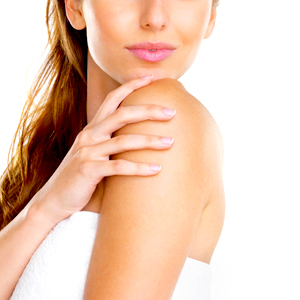... and not in a good way. Some companies add ingredients that aren't listed on the label. While the FDA does mandate that cosmetics cannot contain ingredients that can harm the user (i.e., known harmful substances like lead) or instruct the consumer to use the product in a harmful way (i.e., squirting alcohol into your eyeball), they don't actually regulate or test cosmetics. Testing is left up to the discretion of the manufacturer, so ask yourself: do you trust your favorite beauty brands to conduct rigorous tests of their own products?
Alcide calls out companies that slap "all-natural" on the label, but don't always live up to the claim, ingredient-wise. She sees a lot of labels that list botanical ingredients and distilled water, but they leave out any mention of preservatives. "If a product has water in it, it must have a preservative. Otherwise, bacteria will form," says Alcide. "Natural preservatives are expensive. When I tested one 'all-natural' water-based product with no preservative listed, I found methylparaben in it. That's a chemical preservative."
P.S. If you're scanning your labels a little more closely now, look for ingredients like aloe vera juice, honey, and any type of oil -- these are particularly susceptible to bacteria.
Alcide calls out companies that slap "all-natural" on the label, but don't always live up to the claim, ingredient-wise. She sees a lot of labels that list botanical ingredients and distilled water, but they leave out any mention of preservatives. "If a product has water in it, it must have a preservative. Otherwise, bacteria will form," says Alcide. "Natural preservatives are expensive. When I tested one 'all-natural' water-based product with no preservative listed, I found methylparaben in it. That's a chemical preservative."
P.S. If you're scanning your labels a little more closely now, look for ingredients like aloe vera juice, honey, and any type of oil -- these are particularly susceptible to bacteria.
There's nothing wrong with glossing over the ugly parts -- except in your cosmetics. Alcide says many skin care lines use chemical names of ingredients to make them sound less scary or gross to consumers. Example: you'd probably be wary of slathering your face in formaldehyde (a known carcinogen), but you probably wouldn't bat an eye at "methanal" on the ingredient list. According to Alcide, it's the same thing, and you'll find this preservative in everything from hair-smoothing products to makeup remover. The same goes for common household bleach, which lives incognito in your beauty products under the name "sodium hypochlorite." This chemical has been linked to allergies and is classified as "toxic" by Canada, but it shows up in U.S. stores as an ingredient in disinfectant products meant for skin rashes.
If you're having a heart attack right now because you just discovered methanal listed in your favorite nail polish (and unless it's a "3 Free," it probably is), take Alcide's advice: do your research. "Because there are thousands of skin care products, it is up to the consumer to do their homework reading labels," she says. (A bit obvious, but do you? Ever?) Scour the ingredient list and look up anything you don't recognize. You can look up products and ingredients on the Environmental Working Group's website, or on California's new Safe Cosmetics Program Product Database. More buyer-beware tips from Alcide:
-Consider it a red flag when you buy a product online that only lists "key ingredients." Alcide says this is one way cosmetic companies try to highlight "marketable" ingredients: things that sounds like they're natural or good for you (like avocado oil, orchid extract, and coconut milk), but only make up a tiny percentage of the product. Check out the rest of the ingredients (the FDA's labeling act requires every ingredient to be published in descending order on the bottle or bottle's packaging) to find what the primary ingredients are.
-Be wary of products with an ingredient list printed on the box, versus printed on the bottle. Since you throw out the packaging once you open the product, Alcide says this is another way some cosmetic companies try to gloss over less-than-ideal ingredients. When you decided you want to look up the ingredients, it's too late -- the packaging with the list on it is in last month's trash.
-Be smart about products you buy outside the U.S. Harmful ingredients that are banned in products sold in the U.S. might not be banned elsewhere. Example: Mercury is banned in the U.S., but not in China. Europe has 1,373 ingredients on their banned list. The U.S. list of banned ingredients clocks in at ... eight.
-Consider it a red flag when you buy a product online that only lists "key ingredients." Alcide says this is one way cosmetic companies try to highlight "marketable" ingredients: things that sounds like they're natural or good for you (like avocado oil, orchid extract, and coconut milk), but only make up a tiny percentage of the product. Check out the rest of the ingredients (the FDA's labeling act requires every ingredient to be published in descending order on the bottle or bottle's packaging) to find what the primary ingredients are.
-Be wary of products with an ingredient list printed on the box, versus printed on the bottle. Since you throw out the packaging once you open the product, Alcide says this is another way some cosmetic companies try to gloss over less-than-ideal ingredients. When you decided you want to look up the ingredients, it's too late -- the packaging with the list on it is in last month's trash.
-Be smart about products you buy outside the U.S. Harmful ingredients that are banned in products sold in the U.S. might not be banned elsewhere. Example: Mercury is banned in the U.S., but not in China. Europe has 1,373 ingredients on their banned list. The U.S. list of banned ingredients clocks in at ... eight.
The company trying to sell you a product (a.k.a. the marketer) and the cosmetic chemist who formulates it aren't exactly chatting over the water cooler at lunch or buying each other margaritas at happy hour. In fact, these two have very little (if any) contact with each other. While the brand might tell the chemist they want a certain type of product with a marketable ingredient -- an anti-aging cream with mango, or a night mask with sea algae, for example -- Frey (the chemist who has worked with Avon, Proctor & Gamble and Jafra) says that's pretty much the only information the chemist receives about the product.
Once the product is developed, the packaging is completely in the hands of the marketing company. According to Frey, some marketers simply use trendy words that consumers will be excited to see on the product. "Detoxifying," "purifying," and "renewing" are a few that come to mind, but these beauty buzzwords may have nothing to do with the actual product. "I can go look at their formula and look at claims and do the science behind it, and see if their assessment matches based on what I see with it," says Frey.
To avoid buying into bogus claims, Alcide says to check the order of the ingredients. Ingredients are listed in order based on the percentage they make up in the product. "If water is listed first, that means it's mostly water and is probably full of cheap fillers," says Alcide. If the "key" ingredient is listed dead last, it means the "detoxifying" or "anti-aging" ingredient makes up a tiny percentage of the product.
Once the product is developed, the packaging is completely in the hands of the marketing company. According to Frey, some marketers simply use trendy words that consumers will be excited to see on the product. "Detoxifying," "purifying," and "renewing" are a few that come to mind, but these beauty buzzwords may have nothing to do with the actual product. "I can go look at their formula and look at claims and do the science behind it, and see if their assessment matches based on what I see with it," says Frey.
To avoid buying into bogus claims, Alcide says to check the order of the ingredients. Ingredients are listed in order based on the percentage they make up in the product. "If water is listed first, that means it's mostly water and is probably full of cheap fillers," says Alcide. If the "key" ingredient is listed dead last, it means the "detoxifying" or "anti-aging" ingredient makes up a tiny percentage of the product.
Perusing the aisles of the drugstore, you've probably seen that just about every brand name beauty product has a generic version. Flip them over and you'll see the exact same ingredients, in the exact same order. The only difference? The price. Still, you can't help but wonder, there must be something different about that brand name version to make it 20-40 percent more expensive ... right?
Wrong, according to Alcide, who says that the generic, pharmacy brand versions are the exact same thing as the brand name stuff. In fact, in order for big brands to get shelf space in stores like CVS, they have to be okay with CVS placing their (almost identical) product package next to the brand name product.
However, our editorial team can attest, there is an upside to plunking down for brand name goods. That high-end packaging you're paying for can do a better job protecting the product (and your investment) or make the product more user-friendly. As in, it doesn't break the first time it hits your bathroom floor or squirt sideways out of the canister. Our editorial staff tested a slew of generic beauty products, and although we gave a thumbs-up to some knock-offs, we also noticed that the packaging often ruined whatever quality or value there was in the off-brand version.
And Alcide makes sure to clarify that it's only the imitators that generic skin care brands are equal to. While a pharmacy brand moisturizer might be equal to a similarly packaged brand name drugstore moisturizer, that doesn't mean it's on par with a high-end line found in department stores. "The reason you are getting a a skin care product for $10 versus $60 is because the cheap product is mostly water and fillers without a high amount of active ingredients," explains Alcide.
Wrong, according to Alcide, who says that the generic, pharmacy brand versions are the exact same thing as the brand name stuff. In fact, in order for big brands to get shelf space in stores like CVS, they have to be okay with CVS placing their (almost identical) product package next to the brand name product.
However, our editorial team can attest, there is an upside to plunking down for brand name goods. That high-end packaging you're paying for can do a better job protecting the product (and your investment) or make the product more user-friendly. As in, it doesn't break the first time it hits your bathroom floor or squirt sideways out of the canister. Our editorial staff tested a slew of generic beauty products, and although we gave a thumbs-up to some knock-offs, we also noticed that the packaging often ruined whatever quality or value there was in the off-brand version.
And Alcide makes sure to clarify that it's only the imitators that generic skin care brands are equal to. While a pharmacy brand moisturizer might be equal to a similarly packaged brand name drugstore moisturizer, that doesn't mean it's on par with a high-end line found in department stores. "The reason you are getting a a skin care product for $10 versus $60 is because the cheap product is mostly water and fillers without a high amount of active ingredients," explains Alcide.
Two cosmetic chemists dish on the secrets behind making cosmetics that big name cosmetic companies don't want you to know.




